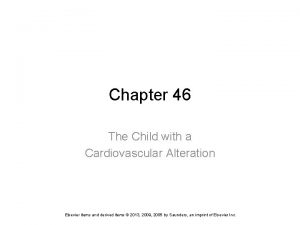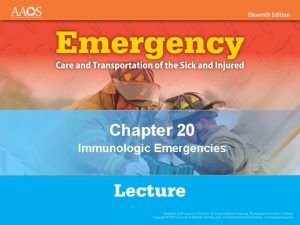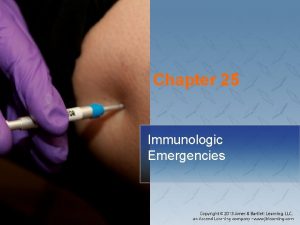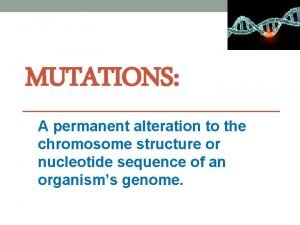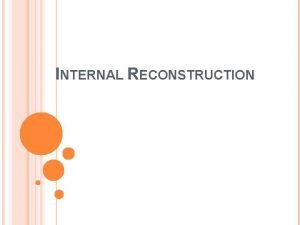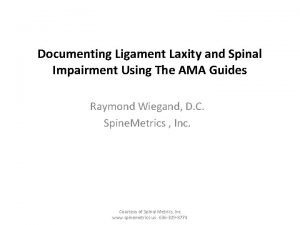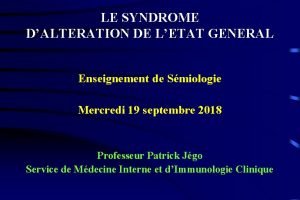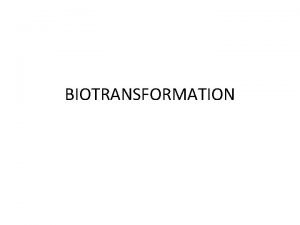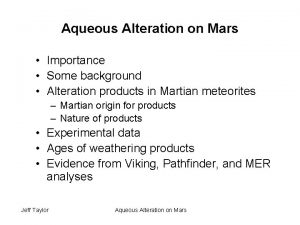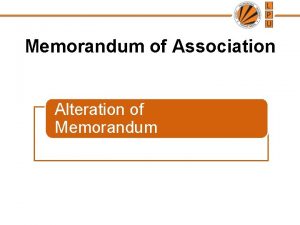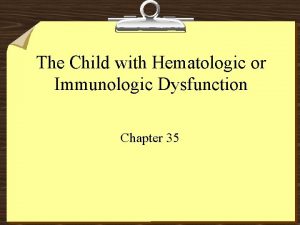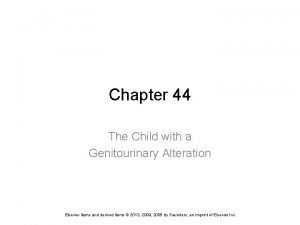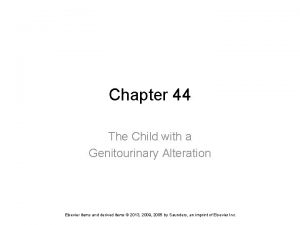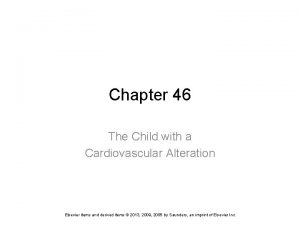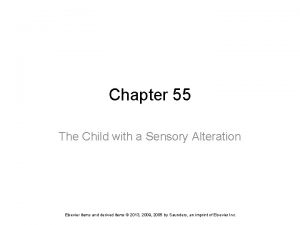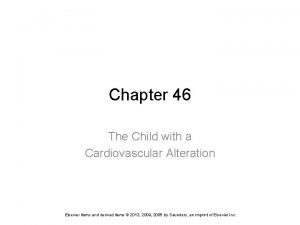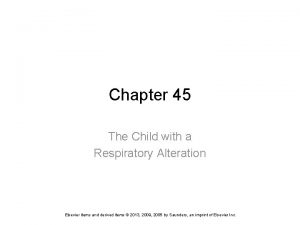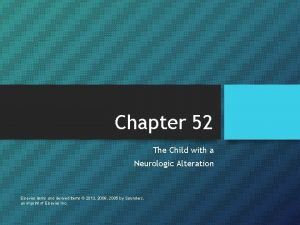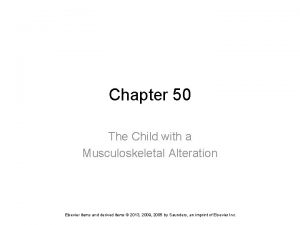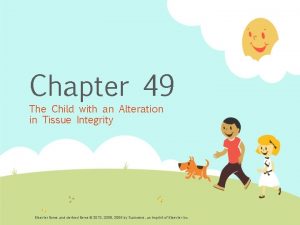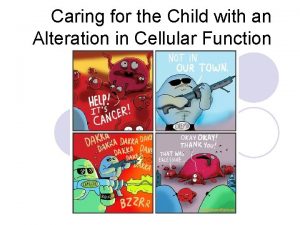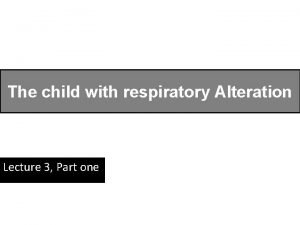Chapter 42 The Child with an Immunologic Alteration

















- Slides: 17

Chapter 42 The Child with an Immunologic Alteration Elsevier items and derived items © 2013, 2009, 2005 by Saunders, an imprint of Elsevier Inc.

Nonspecific Immune Function Chemical barriers Inflammation Increased capillary permeability Vasodilation Phagocytosis Elimination of cellular waste products Elsevier items and derived items © 2013, 2009, 2005 by Saunders, an imprint of Elsevier Inc. 2

Specific Immune Function Humoral response Cell-mediated response Development of immunity Actively acquired Ø Passively acquired Ø Elsevier items and derived items © 2013, 2009, 2005 by Saunders, an imprint of Elsevier Inc. 3

Immunologic Imbalance Under function Ø Increased susceptibility to infection Over function Produces antibodies against cells of the body Ø Allergies Ø Autoimmune disease Ø Elsevier items and derived items © 2013, 2009, 2005 by Saunders, an imprint of Elsevier Inc. 4

Acquired or Congenital Immunodeficiency Increased vulnerability to viral or bacterial infections Ø Appropriate hand hygiene and infection control practices Three guiding principles Prevent contact was organisms. Ø Create barriers if contact is unavoidable. Ø Kill organisms if contact is made. Ø Elsevier items and derived items © 2013, 2009, 2005 by Saunders, an imprint of Elsevier Inc. 5

HIV Infection Best known acquired immunodeficiency disease Causes a widespread spectrum of illnesses in children Symptoms range from mild to severe Elsevier items and derived items © 2013, 2009, 2005 by Saunders, an imprint of Elsevier Inc. 6

Transmission of HIV can be spread by the following: Unprotected sexual activity Sharing of needles An infected mother to her baby Breastfeeding Open wounds (if there is blood-to-blood contact) Elsevier items and derived items © 2013, 2009, 2005 by Saunders, an imprint of Elsevier Inc. 7

Treatment of HIV Modified immunization program Antiretroviral therapy Pneumocystis carinii pneumonia (PCP) prophylaxis Aggressive use of antibiotics Elsevier items and derived items © 2013, 2009, 2005 by Saunders, an imprint of Elsevier Inc. 8

Nursing Challenges Respiratory management Promoting normal growth and development Preventing infection Providing comfort Supporting families Infection transmission Medication adherence Elsevier items and derived items © 2013, 2009, 2005 by Saunders, an imprint of Elsevier Inc. 9

The Child Taking Oral Corticosteroids Both immunosuppressive and antiinflammatory properties During cessation of therapy, gradually taper the dose to allow for a gradual return of adrenal function. Elsevier items and derived items © 2013, 2009, 2005 by Saunders, an imprint of Elsevier Inc. 10

Immune Complex and Autoimmune Disorders Immune complex Kawasaki disease Ø Glomerulonephritis Ø Autoimmune disorders Ø Systemic lupus erythematosus (SLE) Elsevier items and derived items © 2013, 2009, 2005 by Saunders, an imprint of Elsevier Inc. 11

Elsevier items and derived items © 2013, 2009, 2005 by Saunders, an imprint of Elsevier Inc. 12

Types of Allergic Reactions Type I: immediate (anaphylactic) hypersensitivity Ø Examples: allergic rhinitis, acute anaphylaxis, hives, eczema, asthma Type II: cytotoxic hypersensitivity Ø Examples: transfusion reaction after receiving incompatible blood Elsevier items and derived items © 2013, 2009, 2005 by Saunders, an imprint of Elsevier Inc. 13

Types of Allergic Reactions (cont. ) Type III: arthus hypersensitivity (immune complex) Ø Examples: serum sickness, glomerulonephritis Type IV: delayed cell-mediated hypersensitivity Ø Examples: contact dermatitis (poison ivy) Elsevier items and derived items © 2013, 2009, 2005 by Saunders, an imprint of Elsevier Inc. 14

Initial Symptoms of Impending Anaphylaxis Sneezing Tightness, tingling of mouth or face, with subsequent swelling of lips and tongue Severe flushing, urticaria, and itching, especially on head and upper trunk Rapid development of erythema Sense of impending doom Elsevier items and derived items © 2013, 2009, 2005 by Saunders, an imprint of Elsevier Inc. 15

Managing Anaphylactic Shock Ensure an adequate airway, possibly by endotracheal intubation. Administer epinephrine. Administer oxygen if available. Administer corticosteroids and antihistamines as ordered. Keep the child warm and lying flat or with feet slightly elevated. Start an intravenous (IV) line. Elsevier items and derived items © 2013, 2009, 2005 by Saunders, an imprint of Elsevier Inc. 16

Question Which intervention is a priority for a nurse caring for a child with anaphylaxis? Providing supplemental oxygen B. Ensuring an adequate airway C. Initiating IV access D. Administering corticosteroids A. Elsevier items and derived items © 2013, 2009, 2005 by Saunders, an imprint of Elsevier Inc. 17
 Chapter 46 the child with a cardiovascular alteration
Chapter 46 the child with a cardiovascular alteration Care for a victim of an immunologic emergency
Care for a victim of an immunologic emergency Immunologic emergencies
Immunologic emergencies Alteration in various aspect of society over time
Alteration in various aspect of society over time Chromosomal mutations
Chromosomal mutations Internal reconstruction means
Internal reconstruction means Ligamenta flava
Ligamenta flava 337 faa
337 faa Feed enzyme
Feed enzyme Metafora air tenang
Metafora air tenang Factors affecting social change slideshare
Factors affecting social change slideshare Kinds of share capital
Kinds of share capital Maigreur constitutionnelle et fatigue
Maigreur constitutionnelle et fatigue Chemical alteration definition
Chemical alteration definition Alterations in urinary elimination
Alterations in urinary elimination Bare land strata insurance
Bare land strata insurance 전위 순회
전위 순회 Hát kết hợp bộ gõ cơ thể
Hát kết hợp bộ gõ cơ thể
